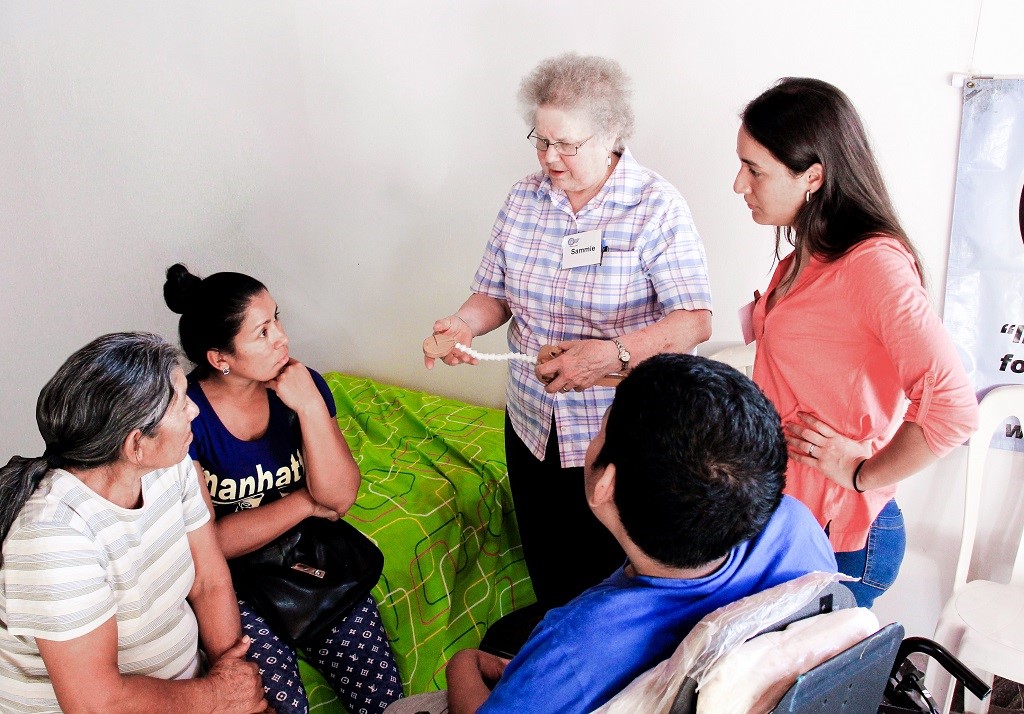![[Image: Eleanore’s Project]](https://fabbaloo.com/wp-content/uploads/2020/05/MG_0853-3EleanoresProject_img_5eb09b8c02903.jpg)
Finding the right fit in tech is important for finding the right fit for patients.
Eleanore’s Project is a nonprofit with a simple, yet profound, mission:
“To improve the lives of children with disabilities and their families through education and through innovative projects that have potential to produce lasting change.”
The nonprofit was founded after occupational therapist Tamara Kittelson-Aldred’s daughter Eleanore, who had been born with multiple disabilities, passed away unexpectedly in 2001. Eleanore had had to use a wheelchair, and Kittelson-Aldred created the project to enhance the quality of life for children like Eleanore around the world.
Active primarily in Peru, Eleanore’s Project is bringing adaptive technology to resource-limited areas. A large part of the effort involves education for children and their families. Not many new to life with wheelchairs realize the impact that posture and supports can have on spinal curvature and overall health.
Eleanore’s Project board member and occupational therapist Sammie Wakefield worked with Kittelson-Aldred to create a simplified anatomical model to work as a posture demonstrator. They called the model Hammie, and Wakefield handmade each from wood — until VA rehabilitation engineer and ex-rocket scientist Brian Burkhardt introduced 3D printing to the effort in 2016.
“Man,” thought Burkhardt when examining the wooden model, “I bet you I could model this up in SOLIDWORKS and we could print these things way easier than you can make them by wood.”
So he did. Working initially with ABS on a fairly standard 3D printer, Burkhardt soon moved his efforts over to a new machine he had just received. The Markforged 3D printer and Onyx material sped up the iteration process and ultimately halved the costs of Hammie creation. Earlier Hammies had required $100 in materials, but the revamped Hammies came in at $40 in material with a 35% reduction in weight.
![The original wooden Hammie faces off with Onyx Hammie [Image: Eleanore’s Project]](https://fabbaloo.com/wp-content/uploads/2020/05/20190215_15524628129EleanoresProject_img_5eb09b8c72c6e.jpg)
Iterating not only in design but in 3D printer and material set Burkhardt on the path to a better for for this specific project — and likely for some additional projects in the future.
Burkhardt, who was volunteering in Peru, took his findings back to the VA. The Veterans Administration hospital system has proven to be an excellent fit for 3D printing in healthcare, with VA operations throughout the US supportive of the technology.
Coupled with the benefits of 3D printing for a broad range of assistive devices, the question is no longer whether 3D printing might be relevant in a hospital setting, but what the best fit solution within 3D printing is.
A variety of 3D printing technologies have been validated for use in hospital settings, such as for FDA-approved patient-specific medical models. With FFF/FDM, SLA, PolyJet, and other processes coming further into play in hospital systems, a wide array of choices are now available for medical teams.
The trick is finding the best fit for a given need.
For Burkhardt, a positive experience in Peru led him to work more with his Markforged machine at the VA. When the VA purchased a Mark Two, Burkhardt noted that using Onyx as opposed to earlier experiences with PLA and BAS “was like night and day.”
The use of 3D printing in hospitals is increasingly becoming commonplace, but all too often that also means the downtime that comes with regular maintenance. Selecting more of a workhorse professional machine than a consumer-level 3D printer will often, while requiring more initial investment, lead to less time tinkering with settings, clearing jams, and working around DIY learning curves, and more consistent, reliable results. When it comes to medical usage, those aspects are key.
Applications in the VA vary, of course, with patient need. Assistive devices tend to be very dependent on the person needing assistance. While one patient may need help holding onto a toothbrush, another may lack the dexterity for creating art, while a third would prefer their wheelchair be equipped with better brake handles or a cupholder. Among Burkhardt’s efforts have been efforts to help an artist develop an adaptive leather punch; create a device for a veteran with a spinal injury to apply her own makeup; and make personalized stylus holders to help use touchscreen devices.
“One of the tenets we adopted early on is we don’t say no,” Burkhardt said. “If this is what you want to do, we’re going to keep working as long as you want to keep working on it. We’re going to keep working with the patient to figure it out.”
Back in Peru, Eleanore’s Project continues to work on its Hammie project. Being able to produce more specific models to help in wheelchair seating mobility will help those with more unique needs in movement. The team is hoping their work will be able to help more people with disabilities understand their bodies’ needs and how to work with their wheelchairs
“We think it’s going to be able to spread some really important concepts in clear and understandable ways so that people will be able to provide better service both here and in other countries,” Kittelson-Aldred said.
With more access to 3D printers and materials to work with, efforts around the world will only continue to see more strong, reliable aids made just for those who need them most.
Via Markforged and Eleanore’s Project











Healthcare 3D printing attempts to solve two problems that plague providing care: customization and cost.